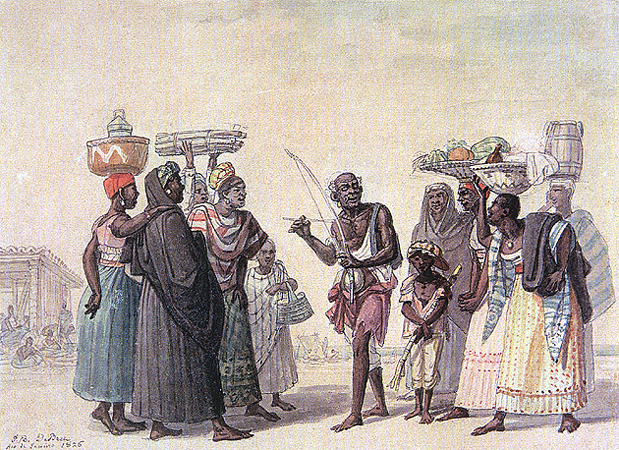|
Capoeira Rhythms
In the game of capoeira, toques are the rhythms played on the berimbau. Many toques are associated with a specific game (i.e. style and speed of play), although organizations differ on how to play each toque. Capoeira toques have their roots in African rhythmic music, which was modified and further developed among the slaves of Brazil. Important toques Some of the more important toques are described below, including; traditional toques, and those created or popularised by Mestre Bimba who was responsible for significant developments to modern capoeira. Notation : = Open berimbau tone. The arame is struck with the dobrão open and the cabaça away from the stomach for a low note, or dobrão pressing firmly for a high note. In this notation, notes that are unfilled are played unmuted rather than representing a half note. : = Muted berimbau note (cabaça is held against the body). : = A buzz (strike the arame with the dobrão resting lightly on the arame and the cabaça against the ... [...More Info...] [...Related Items...] OR: [Wikipedia] [Google] [Baidu] |
Capoeira
Capoeira () is an Afro-Brazilian martial art and game that includes elements of dance, acrobatics, capoeira music, music, and spirituality. It likely originated from enslaved Mbundu people, of the Kingdom of Ndongo, in present-day Angola. The Mbundu of Ndongo had a formal military in which soldiers were professionally trained for combat. When Mbundu people were captured and sold into the Atlantic Slave Trade, they would have brought these fighting abilities with them to Brazil, where it developed into Capoeira. It is known for its acrobatic and complex manoeuvres, often involving hands on the ground and inverted kicks. It emphasizes flowing movements rather than fixed stances; the ''List of capoeira techniques#Ginga, ginga'', a rocking step, is usually the focal point of the technique. Though often said to be a martial art disguised as a dance, capoeira served not only as a form of self defense, but also as a way to maintain spirituality and culture. Capoeira has been practic ... [...More Info...] [...Related Items...] OR: [Wikipedia] [Google] [Baidu] |
Berimbau Angola Variation 2
The berimbau (, borrowed from Kimbundu ''mbirimbau'') is a traditional Angolan musical bow that is commonly used in Brazil. It is also known as ''sekitulege'' among the Baganda and Busoga. It consists of a single-stringed bow attached to a gourd resonator and is played with a stick and a coin or stone to create different tones and rhythms. The berimbau was used in many parts of Africa and Brazil during the 19th century to accompany chants and storytelling. It is part of the candomblé tradition, later incorporated into the Afro-Brazilian art capoeira. Until the mid-20th century, it was used almost exclusively within the black community, but after the popularization of capoeira, it gain wider popularity. Today, berimbau is used in various genres of popular music. History Berimbau is an adaptation of African gourde musical bows, as no Indigenous Brazilian or European people use musical bows. According to the musicologist Gerard Kubik, the ''berimbau'' and the "southwest Ang ... [...More Info...] [...Related Items...] OR: [Wikipedia] [Google] [Baidu] |
Manuel Dos Reis Machado
Manuel dos Reis Machado, commonly called Mestre Bimba (; November 23, 1900 – February 5, 1974), was a Brazilian capoeira ''mestre'' and the founder of the '' capoeira regional'' style. Bimba was one of the best capoeiristas of his time, undefeated in numerous public challenges against fighters from various martial arts. Bimba came from capoeira Angola, and taught Angola style. He reformed capoeira primarily in response to Burlamaqui and Sinhôzinho's attempts to strip it of music and African traditions, and transform it into a mere set of bodily techniques. On the other hand, he was unsatisfied with capoeira Angola of his time, because of its emphasis on rituals and ineffective kicks. Bimba encouraged adding new kicks to capoeira, as long as they were effective and incorporated into the basic footwork, ''ginga''. In declaration of his style in 1936, Bimba claimed to have subtracted two and added 15 kicks to traditional capoeira. Later, this number rose to 52 techniques fro ... [...More Info...] [...Related Items...] OR: [Wikipedia] [Google] [Baidu] |
Berimbau Sao Bento Pequeno
The berimbau (, borrowed from Kimbundu ''mbirimbau'') is a traditional Angolan musical bow that is commonly used in Brazil. It is also known as ''sekitulege'' among the Baganda and Busoga. It consists of a single-stringed bow attached to a gourd resonator and is played with a stick and a coin or stone to create different tones and rhythms. The berimbau was used in many parts of Africa and Brazil during the 19th century to accompany chants and storytelling. It is part of the candomblé tradition, later incorporated into the Afro-Brazilian art capoeira. Until the mid-20th century, it was used almost exclusively within the black community, but after the popularization of capoeira, it gain wider popularity. Today, berimbau is used in various genres of popular music. History Berimbau is an adaptation of African gourde musical bows, as no Indigenous Brazilian or European people use musical bows. According to the musicologist Gerard Kubik, the ''berimbau'' and the "southwest Ang ... [...More Info...] [...Related Items...] OR: [Wikipedia] [Google] [Baidu] |


